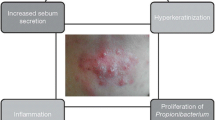Abstract
Increased facial sebum secretion is a common finding during the period when acne commonly develops. Patients with acne frequently think that facial sebum is the cause of their disease and want to lower or remove it completely. Sebum is always listed as one of the important factors involved in the pathogenesis of acne. Quantitative measurement of sebum has only recently become possible; currently, we have limited information on the secretion of sebum itself. The cosmetic skin type is another common method of assessing facial sebum secretion and the skin surface pH (SSPH) is partially affected by facial sebum secretion. In this chapter, sebum secretion, facial skin type, and SSPH will be reviewed with regard to their prognostic significance for acne.
Access this chapter
Tax calculation will be finalised at checkout
Purchases are for personal use only
Similar content being viewed by others
References
Gach JE, Humphreys F. Acne of the scalp—why is it so rare? Clin Exp Dermatol. 2001;26:101–2.
Mourelatos K, Eady EA, Cunliffe WJ, et al. Temporal changes in sebum secretion and propionibacterial colonization in preadolescent children with and without acne. Br J Dermatol. 2007;156:22–31.
Youn SW, Park ES, Lee DH, et al. Does facial sebum secretion really affect the development of acne lesions directly? Br J Dermatol. 2005;153:919–24.
Agache P. Sebaceous function assessment. In: Agache P, Philippe H, editors. Measuring the skin. Berlin: Springer; 2004.
Trivedi NR, Cong Z, Nelson AM, et al. Peroxisome proliferators-activator receptors increase human sebum production. J Invest Dermatol. 2006;126:2002–9.
Strauss JS, Pochi PE. The quantitative gravimetric determination of sebum production. J Invest Dermatol. 1961;36:293–8.
Harris HH, Downing DT, Stewart ME, et al. Sustainable rates of sebum secretion in acne patients and matched normal control subjects. J Am Acad Dermatol. 1983;8:200–3.
Powell EW, Beveridge GW. Sebum secretion and sebum composition in adolescent men with and without acne vulgaris. Br J Dermatol. 1970;82:243–9.
Yosipovitch G, Tang M, Dawn AG, et al. Study of psychological stress, sebum production and acne vulgaris in adolescents. Acta Derm Venereol. 2007;87:135–9.
Draelos ZD, Matsubara A, Smiles K. The effect of 2 % niacinamide on facial sebum secretion. J Cosmet Laser Ther. 2006;8:96–101.
Kligman D. Technologies for cutaneous exfoliation using salicylic acid. Dermatol Ther. 2001;14:225–7.
Lee SH, Huh CH, Park KC, et al. Effects of repetitive superficial peels on facial sebum secretion in acne patients. J Eur Acad Dermatol Venereol. 2006;20:964–8.
Perez-Maldonado A, Rünger TM, Krejci-Papa N. The 1450-nm diode laser reduces sebum production in facial skin: a possible mode of action of its effectiveness for the treatment of acne vulagris. Laser Surg Med. 2007;39:189–92.
Bogle MA, Dover JS, Arndt KA, et al. Evaluation of the 1540 nm Erbium: glass laser in the treatment of inflammatory facial acne. Dermatol Surg. 2007;33:810–7.
Hörfelt C, Stenquist B, Larkö O, et al. Photodynamic therapy for acne vulgaris: a pilot study of the dose-response and mechanism of action. Acta Derm Venereol. 2007;87:325–9.
Dreyer C, Krey G, Keller H, et al. Control of the peroxisomal β-oxidation pathway by stimulation of novel family of nuclear hormone receptors. Cell. 1992;68:879–87.
Park SG, Kim YD, Kim JJ, et al. Two possible classifications of facial skin type by two parameters in Korean women: sebum secretion rate (SER) and skin surface relief (SSR). Skin Res Technol. 1999;5:189–94.
Youn SW, Kim SJ, Hwang IA, et al. Evaluation of skin type by sebum secretion: Discrepancies between subjective descriptions and sebum secretion. Skin Res Technol. 2002;8:168–72.
Youn SW, Na JI, Choi SY, et al. Regional and seasonal variations in facial sebum secretions: a proposal for the definition of combination skin type. Skin Res Technol. 2005;11:189–95.
Kim MK, Choi SY, Byun HJ, et al. Comparison of sebum secretion, skin type, pH in humans with and without acne. Arch Dermatol Res. 2006;298:113–9.
Schmid-Wendtner M-H, Korting HC. The pH of the skin surface and its impact on the barrier function. Skin Pharmacol Physiol. 2006;19:296–302.
Kim MK, Choi SY, Byun HJ, et al. Evaluation of gender difference in skin type and pH. J Dermatol Sci. 2006;41:153–6.
Author information
Authors and Affiliations
Corresponding author
Editor information
Editors and Affiliations
Rights and permissions
Copyright information
© 2014 Springer-Verlag Berlin Heidelberg
About this chapter
Cite this chapter
Youn, SW. (2014). Sebum Secretion, Skin Type, and pH. In: Zouboulis, C., Katsambas, A., Kligman, A. (eds) Pathogenesis and Treatment of Acne and Rosacea. Springer, Berlin, Heidelberg. https://doi.org/10.1007/978-3-540-69375-8_41
Download citation
DOI: https://doi.org/10.1007/978-3-540-69375-8_41
Publisher Name: Springer, Berlin, Heidelberg
Print ISBN: 978-3-540-69374-1
Online ISBN: 978-3-540-69375-8
eBook Packages: MedicineMedicine (R0)




